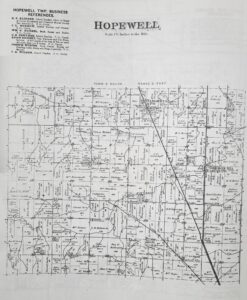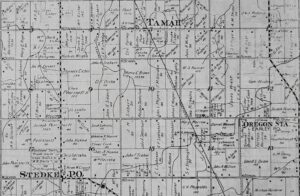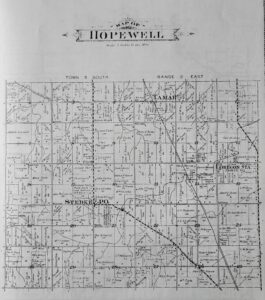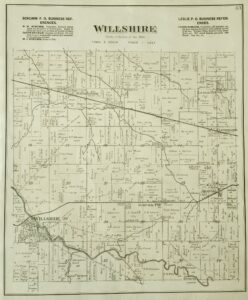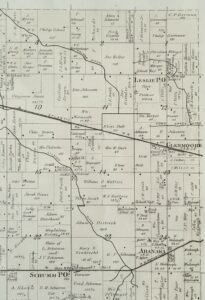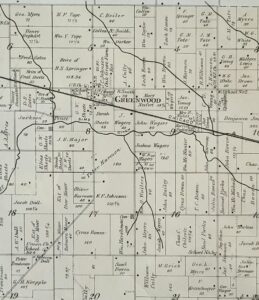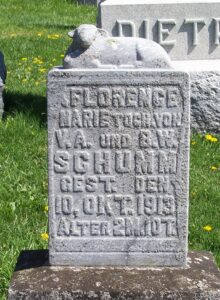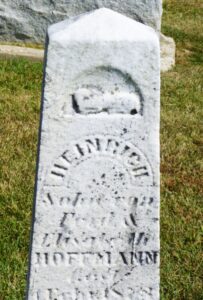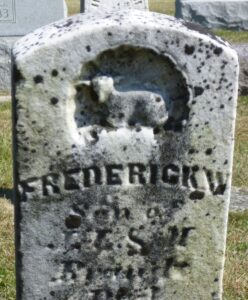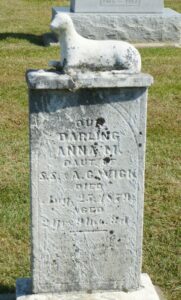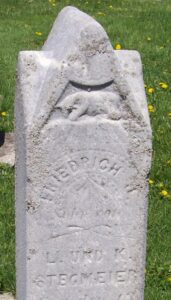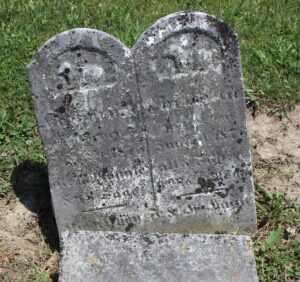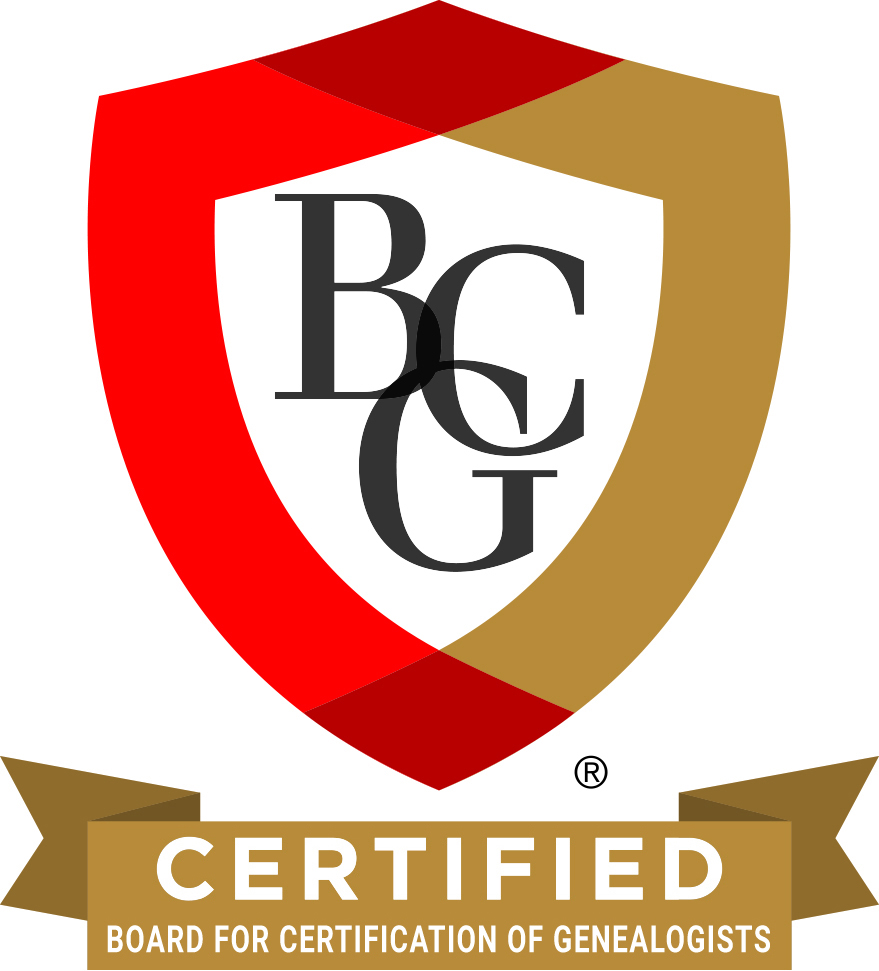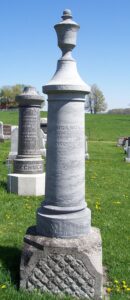
Susanna (Schwab) Kreiselmeyer, Zion Lutheran Cemetery, Van Wert County, Ohio. (2012 photo by Karen)
This is the tombstone of Susanna (Schwab) Kreiselmeyer, located in row 5 of Zion Lutheran Cemetery, Schumm, Van Wert County, Ohio. The marker is inscribed:
Susanna
Ehefrau
Christoph
Kreiselmeyer
Geboren
16 Jan 1831
Gestorben
13 Juni 1894
Alter 63y 4m 28t
Susanna, wife of Christoph Kreiselmeyer, born 16 January 1831, died 13 June 1894, age 63 years, 4 months, 28 days.
Susanna Schwab was born 16 January 1831 in Auburn Township, Crawford County, Ohio, according to her death and burial record at Zion Lutheran Church, Schumm. Her father’s name was David Schwab.
Susanna Schwab married Christoph Kreiselmeyer, a German immigrant, in Crawford County, Ohio, on 7 October 1847. Since Susanna was under 18 years of age her father David Schwab had to give his permission for her to marry. Nice, because that gives us the name of Susanna’s father. [1]
Christoph and Susanna set up housekeeping in Crawford County and were enumerated there in 1850, residing in Cranberry Township with their one-year-old daughter Margaret. Cranberry Township is adjacent to Auburn Township, where Susanna’s family and her father David lived. The Christoph Kreiselmeyer family in 1850: Christoph, 27, Germany; Susanna, 19, Ohio; and Margaret, 1, Ohio. Christoph was a farmer. [2]
Christoph and Susanna Kreiselmeyer moved to Willshire Township about 1854, when Zion Schumm’s records indicate their son John was born. Christoph and Susanna appear to be the first and founding Kreiselmeyers in the Schumm area.
The Christoph Kreiselmeyer family in 1860: Christoph, 38; Susanna, 28, Mary C, 11; David, 9; John, 6; and Hannah, 1. [3]
The Christoph Kreiselmeyer family in 1870: Christoph, 48; Susanna, 39, John, 15; Hannah, 11; Friedrich, 7; Anna, 4; and William, 11 months. [4]
The Christoph Kreiselmeyer family in 1880: Christoph, 58; Susanna, 49; Hannah M, 21; Friedrich G, 17; and Anna RC, 14. [5]
Susanna (Schwab) Kreiselmeyer died of breast cancer on 13 June 1894, at the age of 63 years, 4 months, and 28 days. She was buried on the 15th.
Children of Christoph and Susanna (Schwab) Kreiselmeyer:
Katharina Margaretha Maria “Mary” (1848-1918), married Johann Gottfried Brenner; m. Peter Schmidt
David (1851-1865)
John (1854-1887), married Emma Seeman
“Hannah” Magdalena (1859-1939), married Jacob Gunsett
George Friedrich “Fred” (1863-1923), married Margaretha Buechner
“Anna” Rosine Caroline (1866-1929), married Henry Gunsett
“WIlliam“ Henry (1869-1959), married Laura Langenberger; m. Jessie Juanita Hall
Gottfried Daniel (1875-1875)
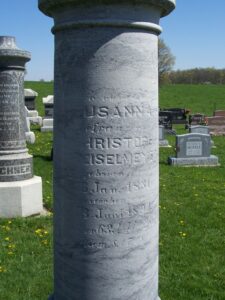
Susanna (Schwab) Kreiselmeyer, Zion Lutheran Cemetery, Van Wert County, Ohio. (2012 photo by Karen)
[1] “Ohio, County Marriages, 1789-2013,” Crawford County Marriages, Vol. 3, p.46, George Christopher Kreisenmeyer & Susanna Schwab, 7 Oct 1847; FamilySearch.org (https://www.familysearch.org/ark:/61903/3:1:939K-BJ3K-HQ?i=46&cc=1614804 : viewed 17 Sep 2018).
[2] 1850 U.S. Census, Cranberry, Crawford, Ohio, p.451B, dwelling 1699, family 1705, Christopher Kriselmire; Ancestry.com (https://www.ancestry.com/search/collections/8054/ : viewed 1 Feb 2021).
[3] 1860 U.S. Census, Willshire, Van Wert, Ohio, p.150 [penned], dwelling 1072, family 1066, Christopher Railselmeyers; Ancestry.com (https://www.ancestry.com/search/collections/7667/ : viewed 17 Sep 2018).
[4] 1870 U.S. Census, Willshire, Van Wert, Ohio, p.436A, dwelling 95, family 96, Christ Kreisshnier; Ancestry.com (https://www.ancestry.com/search/collections/7163/ : viewed 1 Feb 2021).
[5] 1880 U.S. Census, Willshire, Van Wert, Ohio, ED 154, p.449A, family 109, C. Krieselmyer; Ancestry.com (https://www.ancestry.com/search/collections/6742/ : viewed 1 Feb 2021).

